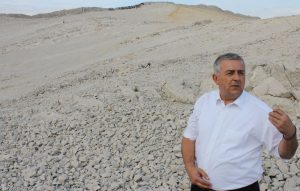
Head of the Association Jadovno 1941 Dusan Bastasic asserts that the new Croatian state is thoroughly and ardently working to reinterpret the history of the Serbs and Croats in the 20th century, focusing on the period of the Independent State of Croatia /NDH/ rule and that it has continued to erase the traces of Serbs’ hardships in Croatia.
Marking the Europe-wide Remembrance Day for the victims of all totalitarian and authoritarian regimes, August 23, as well as the 75th anniversary of the liberation of the Children’s Home in Jastrebarsko in Zagreb County, Bastasic told Srna that the Croatian state project was orchestrated by historians from the Institute of Social Sciences Ivo Pilar in Zagreb, Croatian Society of Victimology, Croatian Memorial-Documentation Centre of the Homeland War, and the Croatian Cultural Council, with the support of Catholic Church leaders.
“After the Croatian combatants in the last war destroyed more than 3,000 monuments to the victims of the 1941-1945 war and burnt more than 2.7 million ‘improper’ books, erasure of the traces of the Serbs’ suffering in Croatia, particularly the revision of their role staging uprisings in Croatia and Bosnia and Herzegovina against fascism and Nazism and the people’s liberation struggle in general, now continues” said Bastasic.
He noted that Jasenovac had thus become a “labour camp” where there was almost no torture or execution of the Serbs, Roma and Jews at all and where “after the war ended, the victims were mostly Croats.”
“The slaughter of the Serbs in the Glina church has been portrayed as a Greater-Serbian lie and a glaring example of instilling collective guilt and genocidal nature in the Croatian people, which has been discussed in a review published by the Croatian Catholic weekly Glas Koncila /Voice of the Council/. The slaughter of the Serbs and Jews at Jadovno was depicted as a result of the late historian Djuro Zatezalo’s mythomania, while they say there isn’t a single bone in the Saran Pit on Mt Velebit, that there’s only just garbage there,” said Bastasic.
He points out that crews organised by a Croatian government agency go down the Karst pits in Lika and on Mt Velebit to “clean out” the bones which they then take to Osijek and store in a so-called temporary grave.
“The camps for women and children or just for children, which the Independent State of Croatia formed at Metajna on the island of Pag, in Sisak, Jastrebarsko, Gornja Reka, Lobor Grad, Kruscica and a few other places, are a thorn in the side and a stain on Croatia’s face, so those sites of torture or execution are now declared ‘admission centres,’ ‘children’s homes for orphans of war,’ etc.,” said Bastasic.
On the other hand, he said, there is not a single word about the horrific truth about the formation of a concentration camp for the Serbian Orthodox Church priests and their families in Caprag near Sisak.
“On these days, when we commemorate the Serb victims of the bloody August of 1941, we also mark the 75th anniversary of the liberation of the surviving Serb orphans from the children’s concentration camp in Jastrebarsko,” Bastasic told Srna.
In a litter over 100 days of its operations, 3,336 children aged 1 to 14, mostly Serbs, went through the NDH concentration camp. More than 2,000 were from Mt Kozara and the region of Potkozarje.
“The children who were transported from Stara Gradiska and Jasenovac to Jastrebarsko in June and July of 1942, had forcibly been separated from their mothers. All of them were suffering from typhus, dysentery, measles, diphtheria or had hunger-induced swollen feet,” Bastasic recounted.
He noted that the nuns from the St Vinko order from Zagreb, who held the management in their own hands, treated the children inhumanely, openly saying that those were “Partisans’ children, they are Serb children, and helping those children means raising the ones who will later slaughter us.”
“The nuns beat up older and healthy children, girls at that, and forced them to sing Ustasha songs and attend Ustashas, who were the nuns’ daily guests. Within a little under six weeks, 768 children died in the camp,” said Bastasic.
Some 500 graves of nameless children behind the fence of the cemetery in Jastrebarsko testify to how Ustasha treated those children and how the nuns treated them, too.
The surviving children were liberated from the concentration camp by the 4th Kordun Brigade of the People’s Liberation Army of Yugoslavia on August 26, 1942.
This Saturday, the Croatian Society of Victimology, Croatian Cultural Council and the local parish are organising a commemoration with a “fitting” programme to mark the Europe-wide Remembrance Day for the victims of all totalitarian and authoritarian regimes and the 75th anniversary of the “Partisan attack” on the Children’s Home for War Orphans in Jastrebarsko.
Wreaths will be laid in the local cemetery after a service in the county church in Jastrebarsko.
This will be followed by a presentation of the origin of the children at the Children’s Home in Jastrebarsko, with the special emphasis on the children from Mt Kozara and the role of Cardinal Aloysius Stepinac, the priests, mercy sisters and other relief associations and individuals in care of the war orphans in Jastrebarsko.
Izvor: SRNA
